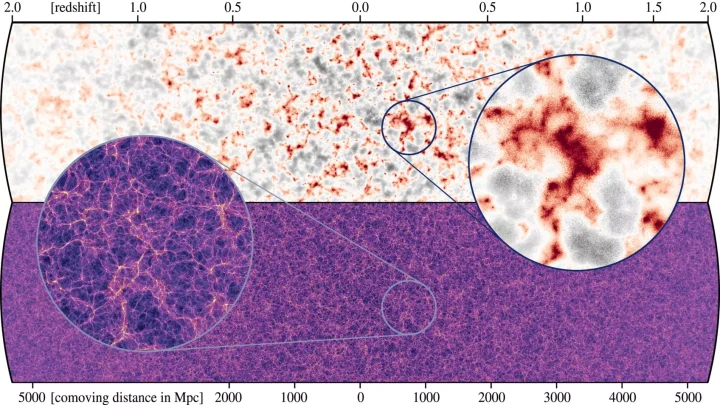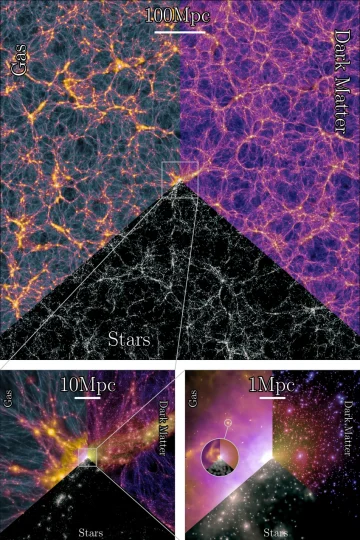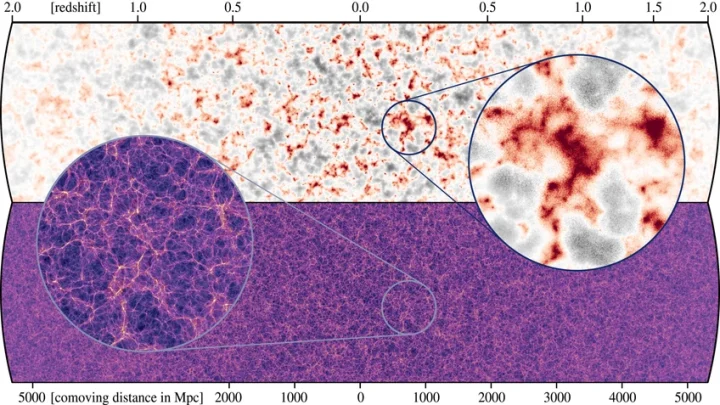New computer simulation of the universe as a promising multitool.

Comparison of the distributions of neutrinos (top) and dark matter (bottom), based on an observer positioned in the middle of each of the two horizontal stripes. As the universe evolves, neutrinos accumulate a little around the largest concentrations of dark matter, as a comparison of the two sections shows. This slightly increases the mass of these largest structures and thus their growth. Image credit: MPG
Cosmological simulations help us look deep into the universe. They are like a theoretical model that we can use to compare the universe as we see it from Earth.
The largest simulations to date deal either with the huge dark matter web-like structures in the Universe or with the details, such as how galaxies and clusters form along these webs.
In this new work, researchers from the Max Planck Institute for Astrophysics and the Universities of Harvard and Durham have brought both together. Their simulation, called “MillenniumTNG,” provides a theoretical basis to put the previous cosmological model to the test.

Two-dimensional projections of the three-dimensional MillenniumTNG simulation at the present epoch. Three different zoom levels illustrate the dynamics of the simulation: from the maximum simulation size of 2400 million light years (top centre) to the size of a single galaxy (bottom right). Each zoom level shows the proportions of gas (top left), dark matter (top right) and starlight (bottom centre). This is based on the largest high-resolution hydrodynamic simulation of the formation of galaxies to date, with more than 160 billion resolution elements. Image credit: MPG
Most of the universe is a mystery
Cosmology gives meaning to astronomical observations of the universe that surrounds us, with physical principles that apply on Earth as well as in the rest of the universe.
This “study of the world” (from the ancient Greek) attempts to describe the universe and its formation as a whole – even at such distances from Earth that are no longer visible to our telescopes.
Modern cosmology tells that the matter known to us only contributes a maximum of five percent to the cosmic mixture. This includes all the planets and stars, which in turn fill countless galaxies. On the other hand, the lion’s share is made up of a mysterious matter that has been christened dark matter.
Indirect observations show that it must exist. However, it has not yet been directly detected. On top of that, a strange field of dark energy seems to act as a kind of anti-gravity, causing the cosmos to expand measurably.
These findings form the standard model of cosmology. It successfully describes the multitude of observational data, from cosmic microwave radiation – the residual heat from the hot Big Bang – to the “cosmic web” in which galaxies and clusters of galaxies are arranged along intertwined filaments of dark matter.
Much in one
However, the actual physical nature of dark matter and dark energy is still not understood, which is why researchers in astrophysics are not only trying to detect dark matter directly, but also to uncover possible gaps in the existing standard model of cosmology.
It is important to theoretically model all the components of the universe “in one go”: from the smallest structures, the stars and galaxies, to the largest interconnected structures between the galaxy clusters. Should this reveal contradictions with the telescopes’ observation data, it could lead science on the trail of perhaps the greatest mystery in the universe.
Researchers at the Max Planck Institute for Astrophysics and an international team have now taken a decisive step forward in simulating the universe as completely and accurately as possible in the computer.
They followed up on their earlier successes with the “Millennium” and “IllustrisTNG” projects and named the resulting simulation “MillenniumTNG”. It traces the physics of the formation of the largest cosmic structures with much greater accuracy than was possible with earlier calculations.
“MillenniumTNG takes into account recent advances in simulating galaxy formation and describes how galaxies connect to the dark matter backbone of the universe,” said Volker Springel, head of the team from the Max Planck Institute for Astrophysics.
The research team used a special computer program called Gadget-4. This program was developed at the Max Planck Institute for Astrophysics.
With the help of Gadget-4, they can simulate dark matter networks in a very large region of ten billion light years.
At the same time, they can study details in this region in detail. They have also used another computer code called Arepo to understand how galaxies formed in the universe’s early days. They can directly compare these models with observations made by the James Webb Space Telescope.
What is dark matter made of?

Comparison of the distributions of neutrinos (top) and dark matter (bottom), based on an observer positioned in the middle of each of the two horizontal stripes. As the universe evolves, neutrinos accumulate a little around the largest concentrations of dark matter, as a comparison of the two sections shows. This slightly increases the mass of these largest structures and thus their growth. Image credit: MPG
The calculations carried out as part of the MillenniumTNG project provide many new theoretical predictions. These predictions can help test fundamental hypotheses. For example: Is part of the dark matter made up of tiny particles called neutrinos?
Neutrinos are special particles that are difficult to detect and have almost no weight. Neutrinos are frequent particles in the universe and could thus contribute a few percent to the total dark matter. On the other hand, earlier simulations of the universe often did not take neutrinos into account for the sake of simplicity.
But now the simulation is large enough to even predict their influence onto the evolution of the universe. Researchers can test this prediction by measuring the universe with telescopes like the European Space Agency’s Euclid satellite. In this way, they might even be able to determine the mass of the neutrinos.
The universe in the supercomputer
The team carried out the calculations of the MillenniumTNG code on two very powerful supercomputers: the SuperMUC-NG at the Leibniz Computing Centre in Garching near Munich and the Cosma8 computer, which is operated by Durham University on behalf of the British DiRAC high-performance computing facility.
More than 120,000 computer cores worked at SuperMUC-NG for almost two months to track how about 100 million galaxies form in a region of the universe about two billion light years across.
Using Cosma8, the team performed calculations for an even larger piece of the universe – large enough to be truly representative of the entire universe for the first time. In this case, it would have been too time-consuming to calculate how matter gradually forms galaxies in small areas at the same time.
Therefore, the researchers used a trick. They took their findings from accurate simulations in a smaller part of the universe and used them to predict how matter and galaxies are distributed in very large areas of the universe.
Source: MPG

